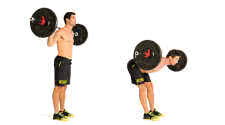Exercise Science: Proper Execution of Good Mornings

Advanced Exercise Science & Research
To say that the good morning has become somewhat of a relic in the gym is probably an understatement. Nevertheless, this is a great exercise. But I'll he frank: I'm nor sure exactly what it's great for - lower hack or hamstrings. When performed correctly, this movement will no
doubt smoke both muscle groups, pack size on both areas and also translate into a bigger squat, deadlift and any other exercise that involves your hamstrings and erectors. I typically do good mornings with either my lower-hack or hamstrings workout.
One reason this lift isn't performed very often may he due to its perceived dangers. As with any exercise, however, proper technique will be your savior. You should be most concerned about your lower back, and the key is to keep a neutral spine position, where you don't round
out your back hut rather maintain its natural curvature. Remember, the curvature of your spine is what provides strength to this structure. Another key is to unlock your knees, which will decrease the stress on your lower back but won't affect exercise performance.
How much should you bend your knees? I'll leave that up to you, but I suggest you go anywhere from a very slight unlock to as much as a quarter-squat position. Your step-by-step approach should observe the following:
1. With the bar in a squat rack or power rack, place it relatively high on your traps in a high-bar squat position.
2. Back out of the rack by 3-5 steps.
3. Take a deep breath and, as you lean forward at the waist, bend your knees to a comfortable degree.
4. Pull the bar down into your traps (this prevents the bar from rolling onto your neck) and lean forward until your torso is almost parallel to the ground. Don t worry if you can't go that deep in the beginning - your hamstrings are probably just too tight. Keep working at
it slowly and you'll he able to get down there.
5. Return to the starting position and, as you ascend, gradually lock out your knees and start breathing out during the last thud of the lift.
6. Try keeping your head in the same position throughout the exercise; don't flex or extend your cervical spine throughout the range of motion.